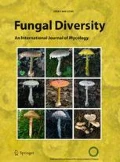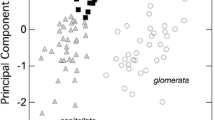Abstract
Phylogenetic studies have shown the need for a revised circumscription of generic boundaries in the jelly lichens (Collemataceae). Using a four-marker dataset from a recently published phylogeny of Collemataceae, we tested the monophyly of ten morphologically well-characterized groups. To achieve this, we performed Bayesian and maximum likelihood analyses. The monophyly of the ten morphological groups was confirmed. In order to reconcile molecular and morphological data into a formal classification, we here propose new generic delimitations in Collemataceae. Collema and Leptogium are re-circumscribed and six old generic names are resurrected to accommodate the Collema Crispum-group (Blennothallia), the Collema Tenax-group (Enchylium), the Collema Cristatum-group (Lathagrium), the Collema Occultatum-group (Rostania), the former small Leptogium species (Scytinium), and Leptogium diffractum (Pseudoleptogium). In addition, two new genera are described to accommodate Collema multipartitum (Callome) and the Collema Italicum-group (Paracollema). The presence/absence of a eucortex, which was earlier used as the cardinal character to define genera in the family, is still useful, but only in combination with other traits such as thallus habit (size), lobe size, ascospore characteristics, thallus anatomical structure, and habitat preference. A key to the genera is provided. Lectotypes are designated for Collema marginale Hoffm., Synechoblastus nigrescens (Huds.) Trevis., Eucollema (Cromb.) Horw., Collema section Enchylium Ach., Collema section Lathagrium Ach., Collema sect. Mallotium Ach., Collema section Scytinium Ach., Collemodium Nyl. ex Lamy, and Homodium Nyl. ex Olivier.





Similar content being viewed by others
References
Acharius E (1810) Lichenographia universalis. Danckwerts, Göttingen
Aragón G, Otálora MAG, Martínez I (2005) New data on the genus Leptogium (lichenized Ascomycetes) in the Iberian Peninsula. Nova Hedw 80:199–226
Awasthi DD, Akhtar P (1977) The genus Leptogium (sect. Mallotium) in India. Norw J Bot 24:59–71
Awasthi DD, Akhtar P (1979) The lichen genus Leptogium (Sects. Leptogium, Leptogiopsis and Homodium) in India. Geophytology 8:189–204
Browne P (1756) The civil and natural history of Jamaica. Osborne and Shipton, London.
Carvalho P (2012) Collema. Flora Liquenológica Ibérica. Vol 10. Sociedad Española de Liquenología, SEL, Pontevedra
Clements FE, Shear CL (1931) The genera of Fungi. MW. Wilson, New York.
Crombie JM (1894) A monograph of lichens found in Britain. Part 1. British Museum, London
Cunha IPR (2007) Fungos liquenizados do gênero Leptogium (Ascomycetes) no litoral sul do Estado de São Paulo. Botucatu SP, Janeiro
Degelius G (1954) The lichen genus Collema in Europe: morphology, taxonomy. Ecology Symb Bot Upsal 13:1–499
Degelius G (1974) The lichen genus Collema with special reference to the extra–European species. Symb Bot Upsal 20:1–215
Dodge CW (1964) Some Lichens of Tropical Africa. IV. Dermatocarpaceae to Pertusariaceae. Beihefte zur Nova Hedwigia, Heft 12. Verlag J. Cramer, Weinheim
Fink B (1910) The lichens of Minnesota. Contr US Nat Herb 14:1–269
Fink B (1918) A new genus and species of the Collemaceae. Mycologia 10:235–238
Flotow J (1850) Ueber Collemaceen. Linnaea 23:147–301
Galloway DJ (2007) Flora of New Zealand Lichens. Lichen-Forming and Lichenicolous Fungi. Vol 1. Manaaki Whenua Press, Lincoln
Galloway DJ, Jørgensen PM (1995) The lichen genus Leptogium (Collemataceae) in southern Chile, South America. In: Daniels FJA, Schultz M, Peine J (eds) Flechten Follmann. Contributions to lichenology in honour of Gerhard Follmann. Bot. inst. Univ. Cologne, Cologne, pp 227–247
Gilbert OL, Jørgensen PM (2009) Leptogium In: Smith CW, Aptroot A. Coppins BJ, Fletcher A, Gilbert OL, James PW, Wolseley PA (eds) The Lichens of Great Britain and Ireland. British Lichen Society, London pp 541–551
Gilbert OL, James PW, Purvis OW (2009) Collema In: Smith CW, Aptroot A. Coppins BJ, Fletcher A, Gilbert OL, James PW, Wolseley PA (eds) The Lichens of Great Britain and Ireland. British Lichen Society, London pp 345–357
Gray SF (1821) A natural arrangement of British plants according to their relations to each other. Baldwin, Cradock and Joy, London
Henssen A (1965) A review of the genera of the Collemataceae with simple spores (excluding Physma). Lichenologist 3:29–41
Henssen A (1981) The lecanoralean centrum. In: Reynolds DR (ed) Ascomycetes systematics. Springer Verlag, New York, pp 139–234
Jørgensen PM (1973a) Über einige Leptogium-Arten von Mallotium-Typ. Herzogia 2:453–468
Jørgensen PM (1973b) On some Leptogium species with short Mallotium hairs. Svensk Bot Tids 67:53–58
Jørgensen PM (1975) Contributions to a monograph of the Mallotium-hairy Leptogium species. Herzogia 3:433–460
Jørgensen PM (1994) Further notes on European taxa of the lichen genus Leptogium, with emphasis on the small species. Lichenologist 26:1–29
Jørgensen PM (1997) Further notes on hairy Leptogium species. Symb Bot Upsal 32:113–130
Jørgensen PM (2007) Collemataceae. Nordic Lichen Flora 3:14–42
Jørgensen PM, Goward T (1994) Two new Leptogium species from western North America. Acta Bot Fenn 150:75–78
Jørgensen PM, James PW (1983) Studies on some Leptogium species of western Europe. Lichenologist 15:109–125
Jørgensen PM, Kashiwadani H (2008) Leptogium loriforme P. M. Jørg. & Kashiw., a new hairy species from Papua New Guinea. Lichenologist 40:123–125
Jørgensen PM, Nash TH III (2004) Leptogium. In: Nash TH III, Ryan BD, Diederich P, Gries C, Bungartz F (eds) Lichen flora of the Greater Sonoran Desert region Vol. 2. Lichens Unlimited, Arizona State University, Tempe, pp 330–350
Jørgensen PM, Olley L (2010) A new hairy Leptogium from Nepal. Lichenologist 42:387–389
Jørgensen PM, Tønsberg T (1999) Notes on some small species of Leptogium from Pacific North America. Bryologist 102:412–417
Jørgensen PM, Otálora MAG, Wedin M (2013) Proposal to conserve the generic name Leptogium (lichenized Ascomycota) with a new type. Taxon 62(6)
Kass RE, Raftery AE (1995) Bayes factors. J Am Stat Assoc 90:773–795
Kitaura MJ, Marcelli MP (2012) The Leptogium juressianum complex in southeastern Brazil. Mycotaxon 120:215–221
Lamy CE (1878) Catalogie raisonné des lichens du Mont-Dore et de la Haute Vienne. Bull Soc Bot France 25:321–536
Lindström M (1993) Leptogium degelii, a new species from South America. Graphis Scripta 5:5–7
Lindström M (2007) New species in the lichen genus Leptogium (Collemataceae) from tropical South America. Biblioth Lichenol 95:405–428
Lopez de Silanes ME, Paz-Bermudez G, Carballal R, Marques J (2012) The genus Leptogium (Collemataceae, Ascomycotina) in mainland Portugal. Sydowia 6:67–102
Magain N, Sérusiaux E (2012) A further new species in the lichen genus Arctomia: A. borbonica from Reunion (Mascarene archipelago). MycoKeys 4:9–21
Massalongo AB (1853) Memorie lichenografiche con un’ appendice alle ricerche sull’ autonomia dei licheni crostosi. HF Münster, Verona.
Miadlikowska J, Lutzoni F (2004) Phylogenetic classification of Peltigeralean fungi (Peltigerales, Ascomycota) based on ribosomal RNA small and large subunits. Am J Bot 91:449–464
Miadlikowska J, Kauff F, Hofstetter V et al (2006) New insights into classification and evolution of the Lecanoromycetes (Pezizomycotina, Ascomycota) from phylogenetic analyses of three ribosomal RNA and two protein–coding genes. Mycologia 98:1089–1102
Müller J (1882) Lichenologische Beiträge 15. Flora 65:291–306
Müller J (1885) Lichenologische Beiträge 22. Flora 68:503–518
Nylander JAA, Ronquist F, Huelsenbeck JP, Nieves-Aldrey LJ (2004) Bayesian phylogenetic analysis of combined data. Syst Biol 53:47–67
Oliver MH (1903) Exposé systématique et description des lichens de l'ouest et du nord-ouest de la France 2. Bazoches-sur-Houlme (Orne), Normadie, Bretagne, Anjou, Maine, Vendée
Otálora MAG, Wedin M (2013) Collema fasciculare belongs in Arctomiaceae. Lichenologist 45:295–304
Otálora MAG, Aragón G, Molina MC et al (2010) Disentangling the Collema–Leptogium complex through a molecular phylogenetic study of the Collemataceae (Peltigerales, lichen–forming Ascomycota). Mycologia 102:279–290
Otálora MAG, Aragón G, Martínez I, Wedin M (2013) Cardinal characters on a slippery slope—a re-evaluation of phylogeny, character evolution, and evolutionary rates in the jelly lichens (Collemataceae s. str). Mol Phylogenet Evol 68:185–198
Ronquist F, Teslenko M, van der Mark P et al (2011) MrBayes 3.2: efficient Bayesian phylogenetic inference and model choice across a large model space. Syst Biol 61:539–542
Shimodaira H, Hasegawa M (2001) CONSEL: for assessing the confidence of phylogenetic tree selection. Bioinformatics 17:1246–1247
Sierk HA (1964) The genus Leptogium in North America and North of Mexico. Bryologist 67:245–317
Spribille T, Muggia L (2013) Expanded taxon sampling disentangles evolutionary relationships and reveals a new family in Peltigerales (Lecanoromycetidae, Ascomycota). Fungal Divers 58:171–184
Stamatakis A (2006) RAxML–VI–HPC: maximum likelihood–based phylogenetic analyses with thousands of taxa and mixed models. Bioinformatics 22:2688–2690
Swinscow TDV, Krog H (1988) Macrolichens of East Africa. British Museum (Natural History), London
Trevisan V (1853) Caratteri di tre nuovi generi di Collemacee. Padova.
Trevisan V (1880) Sulle Garovaglinee, nuovo tribu di Collemacee. Rend R Ist Lomb Scie Lett Ser 2(13):65–77
Tuckerman E (1872) Genera Lichenum: an arrangement of the North American lichens. E Nelson, Amherst
Tuckerman E (1882) A sypnosis of the North American lichens I. Lewiston, Maine
Vainio E (1890) Etude sur la Classification Naturelle et la Morphologie des Lichens du Bresil. Fauna Flora Fenn 7:1–256
Verdon D, Filson RB, Henssen A (1992) Collemataceae. Flora Aust 54:173–192
Wedin M, Wiklund E (2004) The phylogenetic relationships of Lecanorales suborder Peltigerineae revisited. Symb Bot Upsal 34:469–475
Wedin M, Wiklund E, Jørgensen PM, Ekman S (2009) Slippery when wet: phylogeny and character evolution in the gelatinous cyanobacterial lichens (Peltigerales, Ascomycetes). Mol Phylogenet Evol 53:862–871
Wiklund E, Wedin M (2003) The phylogenetic relationships of cyanobacterial lichens in the Lecanorales suborder Peltigerineae. Cladistics 19:419–431
Zahlbruckner A (1907) Lichenes (Flechten), In: Engler A, Prantl K (ed.) Die natürlichen Pflanzenfamilien I. W. Engelmann, Leipzig, pp 49–249.
Zahlbruckner A (1924) Catalogus Lichenum Universalis vol. 3. Borntraeger, Leipzig.
Zahlbruckner A (1926) Catalogus Lichenum Universalis vol. 4. Borntraeger, Leipzig.
Acknowledgments
We thank E. Timdal for kindly authorize us to use photographs published in (http://nhm2.uio.no/botanisk/lav/Photo_Gallery/). M. Prieto is gratefully thanked for providing the habit photo of Leptogium phyllocarpum. J. Klackenberg kindly gave very helpful advice on scientific names and Latin grammar. Two anonymous reviewers provided constructive comments and suggestions. All errors, however, are entirely our own. This research was generously supported by the Swedish Research Council grants VR 621-2009-5372 and VR 621-2012-3990, and by a postdoctoral grant from the Spanish Ministry of Education and Science (EDU3495/2010).
Author information
Authors and Affiliations
Corresponding author
Rights and permissions
About this article
Cite this article
Otálora, M.A.G., Jørgensen, P.M. & Wedin, M. A revised generic classification of the jelly lichens, Collemataceae . Fungal Diversity 64, 275–293 (2014). https://doi.org/10.1007/s13225-013-0266-1
Received:
Accepted:
Published:
Issue Date:
DOI: https://doi.org/10.1007/s13225-013-0266-1




